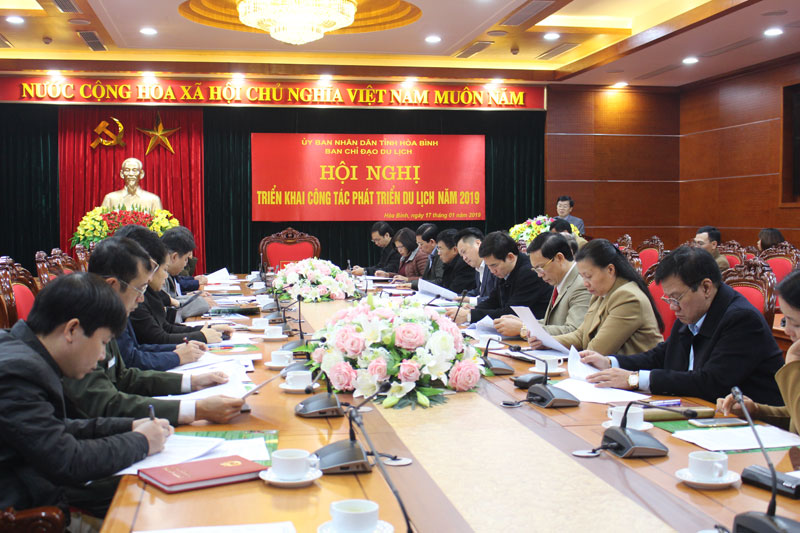
(HBO) – The Hoa Binh Tourism Steering Committee held a conference to summarise its activities in 2018 and set out new tasks for 2019. Nguyen Van Chuong, Vice Chairman of the provincial People's Committee and head of the committee, chaired the function.

Scene at the conference.
In 2018, state management of tourism activities was
strengthened along with tourism promotion, investment as well product and infrastructure
development. The province prioritized its resources for projects within the Hoa
Binh Lake National Tourist Area and Mai Chau National Tourism Site.
Last year, Hoa Binh welcomed nearly 2.7 million
visitors, up 7.9 percent compared to 2017. Of the total, international tourists
exceeded 320,000. The total revenue from tourism reached 844.98 trillion VND.
In 2019, the sector was tasked with raising public
awareness of the national and provincial policies on tourism development, together
with devising preferential mechanisms and policies targeting investors in the
field, and increasing investment in tourism infrastructure and technology. The
province aims to receive more than 2.8 million visitors and earn over 1.9
trillion VND in tourism revenue.
Nguyen Van Chuong, Vice Chairman of the provincial
People's Committee and head of the committee, requested the provincial Department
of Culture, Sports and Tourism to regularly coordinate with related agencies
and sectors to improve the efficiency of tourism promotion programmes.
He urged completing work on a smart tourism
project to put it into operation in the third quarter of 2019 and establishing
the management boards for the Hoa Binh Lake Tourist Area and Mai Chau National Tourism
Site.
He also recommended increasing inspection of tourism projects with slow
progress as well as ensuring environmental sanitation and food safety before,
during and after festive seasons, particularly in Hoa Binh Lake area.
Hoa Binh province is undergoing a dynamic transformation amid Vietnam’s national digital transition. Building on Poliburo’s Resolution No. 57-NQ/TW on breakthroughs in science, technology, innovation, and national digital transformation, the province has rolled out a wide range of practical action plans. A standout initiative is the "Digital Literacy for All” movement, an effort to ensure that no one is left behind in the digital era.
Hoa Binh province is undergoing a dynamic transformation in the wake of the national digital transformation movement. Building on Resolution No. 57-NQ/TW of the Politburo on breakthroughs in science, technology, innovation, and national digital transformation, the province has implemented a wide range of practical action plans. A standout initiative is the "Digital Literacy for All” movement ambitious effort to ensure that no one is left behind in the digital age.
With a spirit of unity and proactive problem-solving, the Party Committee, the government and the people of Dong Lai Commune (Tan Lac District) have made great strides in implementing the resolutions of the 24th Party Congress of the commune for the 2020 - 2025 term. Focusing on leadership and practical actions, the commune has brought the Party’s resolutions into daily life, creating strong impacts and pushing the local development forward.
Amid the nationwide push for digital transformation, young people in Hoa Binh Province are stepping up as dynamic pioneers, applying technology to enhance Youth Union operations and expand the reach of youth-led initiatives. Through creativity and adaptability, Youth Union organizations at all levels have introduced a series of practical solutions, contributing to modern governance and community development.
In recent years, An Nghia commune, located in Lac Son district, has stepped up administrative reform, focusing on improving the quality and efficiency of its single-window service unit for receiving and processing administrative procedures. These improvements have helped create favourable conditions for local residents and organisations to handle administrative procedures, contributing to the commune’s broader socio-economic development.
The Prime Minister-approved master plan to develop the multi-use value of forests ecosystems through 2030, with a vision to 2050, aims to improve the management and sustainable use of forest resources, create jobs, increase incomes, and improve the living standards of ethnic minorities, people in mountainous and remote areas, forest workers and those living near forests.



